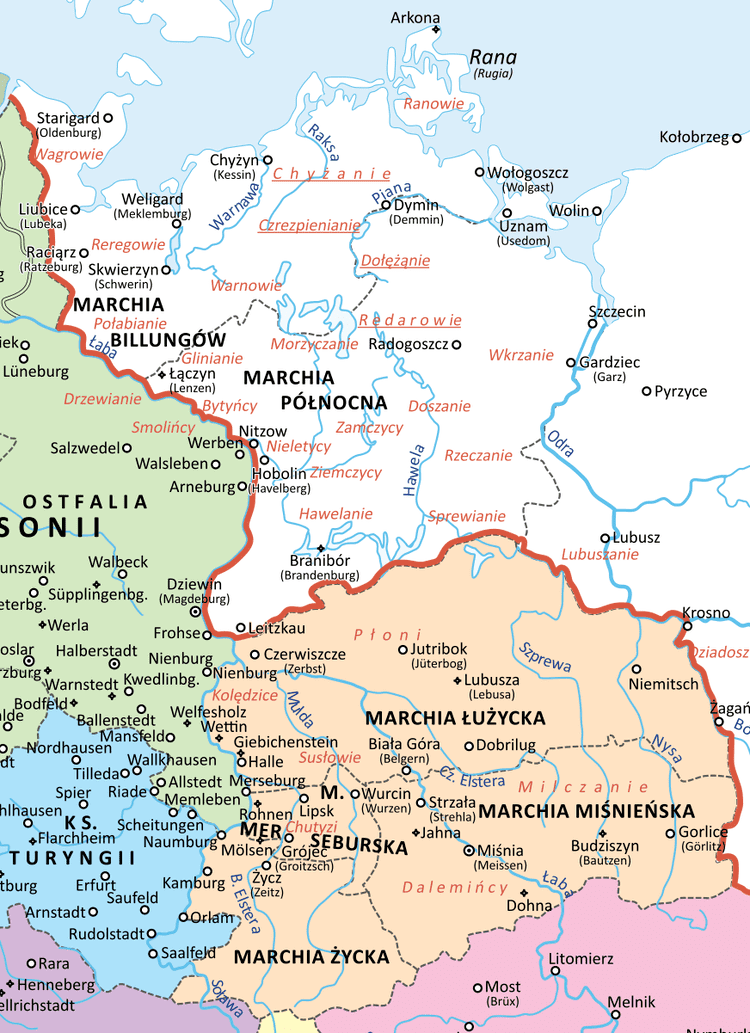 | ||
The Saxon Eastern March (German: Sächsische Ostmark) was a march of the Holy Roman Empire from the 10th until the 12th century. The term "eastern march" stems from the Latin term marchia Orientalis and originally could refer to either a march created on the eastern frontier of the East Frankish duchy of Saxony or another on the eastern border of the Duchy of Bavaria: the Bavarian marchia Orientalis (documented as Ostarrîchi in 996), corresponding to later Austria.
The Saxon Ostmark initially referred to the vast Marca Geronis ('Gero's march'), established about 939 under the rule of King Otto I in the settlement area of the Polabian Slavs (Sorbs), beyond the Saxon Eastern border on the Elbe and Saale rivers. The conquered territories were governed by the Eastphalian legate Gero, count in the Nordthüringgau, who was vested with the Carolingian title of a margrave. It was his task to collect tributes and to overcome riots and revolts in the frontier areas, later partly superseded by Otto's Saxon deputy Hermann Billung. In 963, Gero in late age waged another military campaign against the Slavic Lusatian (Lusici) tribes, up to the border with the Polish lands ruled by Mieszko I.
After Gero had died without heirs in 965, the tributary lands were divided and re-organised by the establishment of the Northern March around Brandenburg, stretching between the Elbe and Oder rivers, as well as the creation of the March of Meissen, the March of Merseburg and the March of Zeitz in the south. The rule over the Northern March was again lost in the Great Slav Rising of 983.
Thereupon, the remaining Saxon Eastern March consisted of the territory between the lower Saale and the Bóbr river in the east, roughly corresponding to the modern region of Lower Lusatia. Emperor Otto I invested the Saxon count Odo (Hodo), one of Gero's relatives, with the title of a Margrave. Over the centuries, the Eastern March emerged as the March of Lusatia.
During the German-Polish War from 1002 to 1018, Odo's successor Gero II lost the eastern part of the march to Bolesław I of Poland, nevertheless Bolesław's son Mieszko II had to return the conquered territory to Emperor Conrad II in 1031. In 1046 Dedi I from the Saxon House of Wettin inherited the march, his son and successor Henry I was in addition granted the March of Meissen by Emperor Henry IV in 1089. Both marches remained under Wettin administration and later became the nucleus of the Saxon Electorate.
While the Margraviate of Landsberg and the County of Brehna split off from the march, further parts in the west were claimed by the Ascanian Dukes of Saxe-Wittenberg and the Counts of Anhalt. The remaining areas were united with the Wettin margraviate of Meissen in 1123. The last time that the Ostmark and Lusatia appear separate is when the former was received by Henry of Groitzsch in 1128 and the latter was reserved until 1131. Henry however did not prevail and by 1136 the march had fallen back to the Wettin margrave Conrad of Meissen. During the various divisions of the Wettin lands, the territory was split up several times; most of it belonged to the Ernestine duchies.
The term Osterland (terra orientalis) is still used today to describe the historic region east of the Saale river in the present-day states of Thuringia, Saxony and Saxony-Anhalt, which was once at the centre of the march. While the borders of the Ostmark changed frequently, in modern times the term is generally understood to mean the area between the rivers Saale and Mulde.
